SEO is alive and kicking in 2025, and it’s evolving faster than ever. Whether you’re a blogger, digital marketer, SaaS founder, or local business owner, it pays to know the latest facts.
In this blog, we will look into up-to-date global SEO statistics for 2025 and more.
We’ll cover everything from organic traffic and ranking factors to voice search, mobile, AI, Core Web Vitals, SERP features, user behavior, content trends, link building, and even expert predictions for the rest of the year.
Let’s get started!
Organic Search Traffic Statistics: Still the King of Web Traffic
Organic search will remain a massive driver of website traffic in 2025. In fact, recent studies show that organic search accounts for about 53% of all website traffic on average, making it the single largest traffic source for most sites.
Despite the rise of social media and other channels, people still turn to search engines (especially Google) to find information, products, and services.
Google’s dominance in this space is as strong as ever.
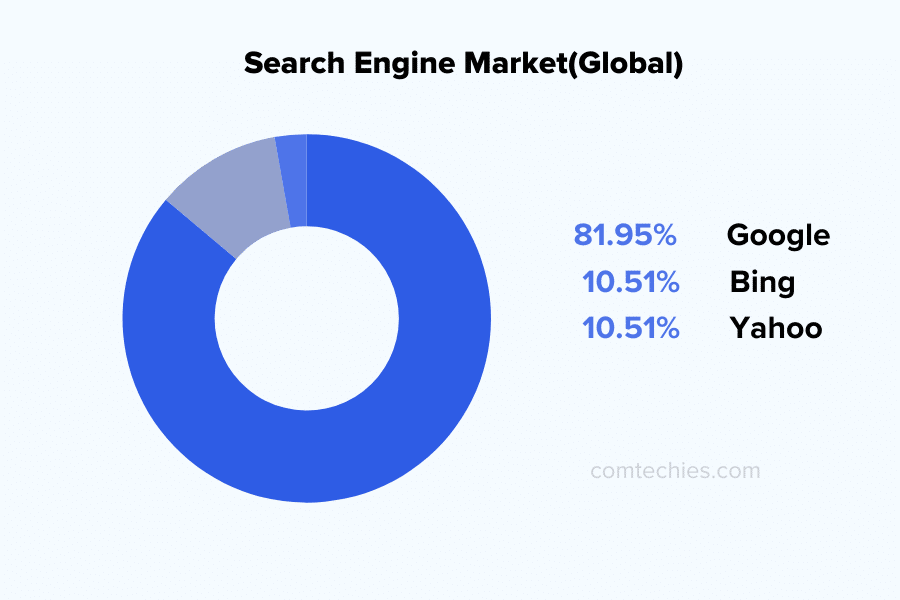
- Google processes roughly 8.3 billion searches per day (96,000 every second), and holds about 81.95% of the global search engine market share.
- Bing’s share is around 10.5%, with Yahoo, Yandex, DuckDuckGo, and others splitting the rest.
- Global Search Engine Market Share (2024): Google leads with an 82% market share, much bigger than competitors.
- For example, on December 31, 2024, Google’s organic search results attracted an estimated 4.6 billion visits, while paid search ads received only about 16.4 million.
However, user behavior in search is changing. A growing number of searches result in no clicks at all.
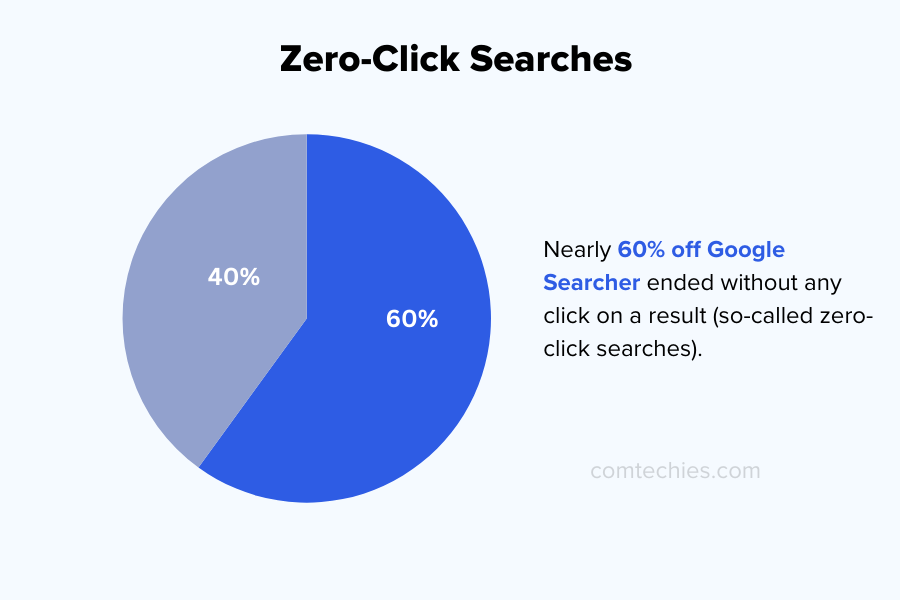
- In 2024, nearly 60% of Google searches ended without any click on a result (so-called zero-click searches).
- Almost 30% of all search clicks in the US go to Google-owned sites
- When you combine zero-click searches with Google self-serving its platforms, only around 36% of Google searches result in a click to an external website in the US.
Why? Often, because Google answered the query directly on the results page (via featured snippets, Knowledge Panels, etc.).
This doesn’t mean SEO is dead, but we have to adapt to a world where getting the click is harder.
A few more statistics on organic search traffic trends.

- In the U.S., nearly 63.4% of all internet traffic originates from Google search referrals.
- Globally, Google is responsible for about 92% of the search traffic hitting websites. That’s huge, it underscores why optimizing for Google is usually priority #1.
- About 15% of daily Google searches are completely new, queries that have never been searched before.
(This stat, which Google has shared for years, highlights the long-tail nature of search and the constant emergence of new keywords. It’s a reminder to create content that can capture unconventional and long-tail queries) - People search not just by typing words, but also using images and their camera. Google Lens, for instance, now handles 20 billion search queries per month, showing the growth of visual search.
Organic search is still crucial of web traffic in 2025, so investing in SEO has a high payoff.
But winning in organic search now requires more than just ranking , you also need to consider how to stand out in a crowded, feature-packed search results page to actually get that click (or at least get the exposure).
We’ll talk about how in the sections on SERP features, content, and AI.
Google’s Top Ranking Factors and Statistics
Google’s algorithm is complex, but SEO experts and studies agree on a few fundamental ranking factors that matter most in 2025.
#1. Content is Still king:
The average word count of a Google first-page result is about 1,447 words. Therefore, providing high-quality, relevant content geared toward user intent is crucial.
In other words, longer in-depth content tends to perform well, likely because it covers topics comprehensively.
That doesn’t mean you should fill your pages with fluff to hit a word count, but it does suggest that thorough content that fully answers the query tends to rank better.
Its Quality Guidelines also reflect Google’s focus on “E-E-A-T” (Experience, Expertise, Authoritativeness, Trustworthiness).
Content that demonstrates the author’s actual experience or expertise on the topic is more likely to be seen as trustworthy.
Additionally, Google is getting better at understanding who is behind content, and they now more adeptly recognize and value author entities, which means that having credible authors can positively influence rankings.
So, invest in creating original, helpful content (blog posts, articles, product pages, etc.) that satisfies the searcher’s intent better than anyone else.
#2. Backlinks Still Matter a Lot:
- Top-ranking pages have significantly more backlinks on average. One analysis found that the #1 result on Google has 3.8 times more backlinks than the pages in positions 2 through 10.
- Over 52% of digital marketers say link building is the most challenging part of SEO.
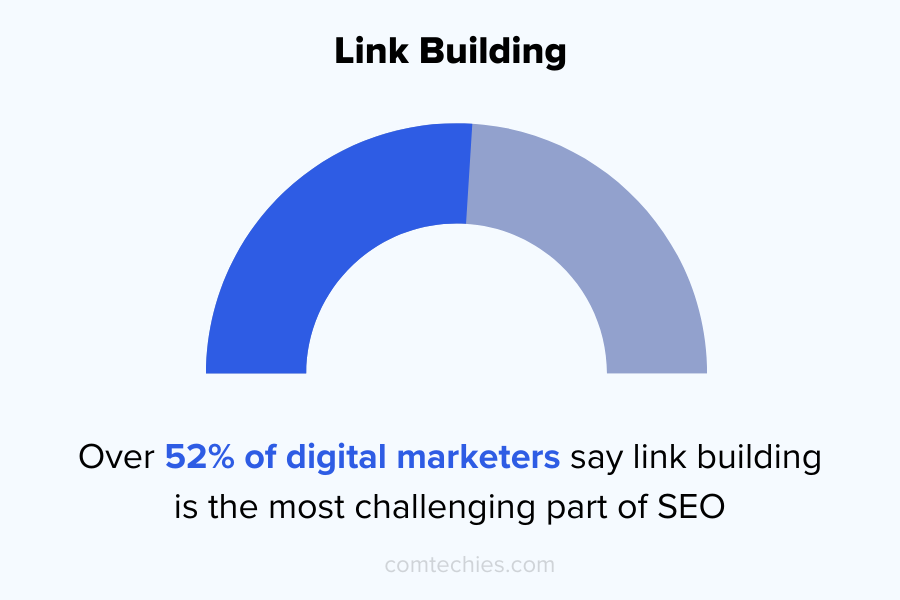
Backlinks remain one of Google’s strongest ranking signals. Google has confirmed that content and backlinks are among its system's top three ranking factors.
So, earning quality links from other websites is still critical for SEO success in 2025.
However, Google continues to change its link algorithms (with things like the SpamBrain system) to ignore low-quality or manipulative links.
So focus on natural, editorial links and avoid spammy link schemes. It’s worth noting that link building isn’t easy. But it’s worth the effort when those links are real and authoritative.
#3. Page experience & Core Web Vitals:
Google’s ranking factors aren’t just about what’s on your page or who’s linking to it, they also include how your site performs for users.
Core Web Vitals (CWV), which measure loading speed, interactivity, and visual stability, became an official part of Google’s algorithm in recent years (the Page Experience update).
- As of late 2023, only 42.5% of websites pass Google’s Core Web Vitals assessment.
- Google’s algorithm updates in 2024 also targeted poor-quality, spammy user experiences. One core update reduced the amount of low-quality, irrelevant content appearing in search results by 45%.
- 42.5% of websites pass Core Web Vitals as of late 2023.
- The pass rate is slightly above 50% on desktop, but it’s well under half on mobile.
- Only 28.4% of the global top 1000 websites passed CWV in one analysis
This means that if you optimize your site to load fast and smoothly, you’ll be ahead of most sites and potentially gain a ranking edge.
It's pretty clear that technical SEO and UX matter.
#4. Keywords & Relevance:
Keyword optimization isn’t dead but is more about context and intent now.
You still want to include the terms people search for (in titles, headings, body text) so Google understands your page’s topic.
But old-school keyword stuffing is a no-go. It’s better to focus on covering subtopics and related queries (think semantic SEO).
- The average top-ranking page ranks for about 1,000 other relevant keywords in the top 10.
- Google rewrites an average of 62.7% of meta descriptions and occasionally ignores/rewrites title tags.

That means Google often ranks a strong page for many variations of a keyword, not just the exact keyword, which is a sign that its understanding of content is semantically rich.
So aim to create comprehensive content that can “rank for anything” around your topic.
Research shows that Google sometimes rewrites your title tags and meta descriptions if it thinks they can do better.
Now, let’s look at some specific areas such as voice, mobile, local, and how new trends are playing out.
Voice Search Statistics: The Rise of Voice Queries
With smartphones and smart speakers everywhere, more people are searching by voice for quick answers or local info.
Here are some notable voice search stats and trends in 2025.
- By one recent survey, 62% of American adults use voice search regularly(through digital assistants like Siri, Google Assistant, Alexa, etc.).
- Google has noted that roughly 20% of users have used voice search.
- 60% of smartphone users have tried voice search at least once in the past year
- About 20% of all voice searches use just 25 common keywords. Mostly question words like “how,” “what,” “best,” or “easy.”
- A large share of voice searches have local intent. Google has noted that “near me” searches and other local queries are often done via voice, and 46% of all Google searches in general seek local information.
- In 2024, 58% of consumers have used voice search to find local business information.
- 76% of people who search for something nearby (e.g., “coffee shop near me”) visit a related business within a day.
- 80% of Google Assistant’s voice answers come from the top three organic search results.
- 70% of voice search results are drawn from either a Featured Snippet or a People Also Ask result on Google.
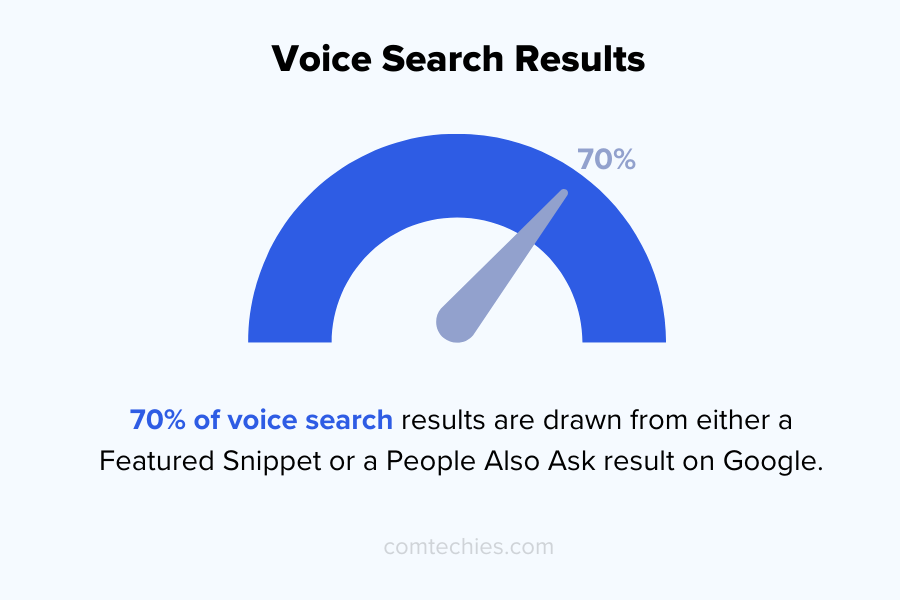
Optimizing for voice search is about answering questions clearly and briefly. Consider your audience's questions about your business, and incorporate those Q&As into your content.
Use natural language and long-tail keywords.
And since many voice searches are local, ensure your local SEO (business listings, reviews, location pages) is in top shape.
Mobile SEO: The Mobile-First World
It’s no surprise that mobile phones will dominate search in 2025. We’ve been hearing “mobile-first” for years, and now it’s entirely a reality.
Here are the key stats and implications for mobile SEO.
- Over 70% of Google searches now come from mobile devices.
- Web traffic and mobile accounts account for about 58.7% of global website visits (excluding tablets).
- 58% of mobile searchers are likely looking for local or immediate information(like directions, phone numbers).
- A recent analysis found that almost half (46%) of mobile searches in the EU ended with no further activity (no click or second search), which is over 2X the rate of such “no action” searches on desktops.
Optimize for mobile first. Ensure your site loads fast on 3G/4G connections, is easy to use on a small screen, and contains all the content and keywords you want Google to see.
Test your pages on an actual phone, experience what your users experience. If something is annoying on mobile, fix it.
Local SEO Statistics
Local SEO has become a huge part of the search landscape, as more searches include local intent (“near me” queries, city-specific services, etc.).
- According to the 2024 report, around 46% of all Google searches have local intent.
- 77% of consumers use Google when looking for local business information.
- In 2022, 87% of consumers used Google to evaluate local businesses (reading reviews, checking hours, etc.).
- According to Google's research, 28% of those searches result in a purchase.
- 98% of people read online reviews for local businesses.
- 49% of consumers trust online reviews as much as personal recommendations.
If local customers are your target, prioritize local SEO. Claim and optimize your Google Business Profile (accurate info, category, hours, photos, and encourage happy customers to leave reviews).
Optimize your website with localized content and on-page SEO for local keywords. For multi-location businesses, create individual location pages.
SERP Features Statistics: Snippets, ‘People Also Ask’, and More
Modern Google search results are filled with SERP features, special boxes and enhancements that provide answers or additional info right on the results page.
Let’s look at some key SERP features and stats around them.
- According to research, 50–65% of all Google's number-one positions are now occupied by featured snippets.
- By some estimates, roughly 43% of Google search results include a People Also Ask(PAA) box. That means that on nearly half of the searches, Google suggests follow-up questions.
- The click-through rate (CTR) on PAA results themselves is about 3%, which is relatively low compared to the main results.
- 91% of companies now use video as a marketing tool, and Google has been integrating more video content into SERPs for how-to and informational queries.
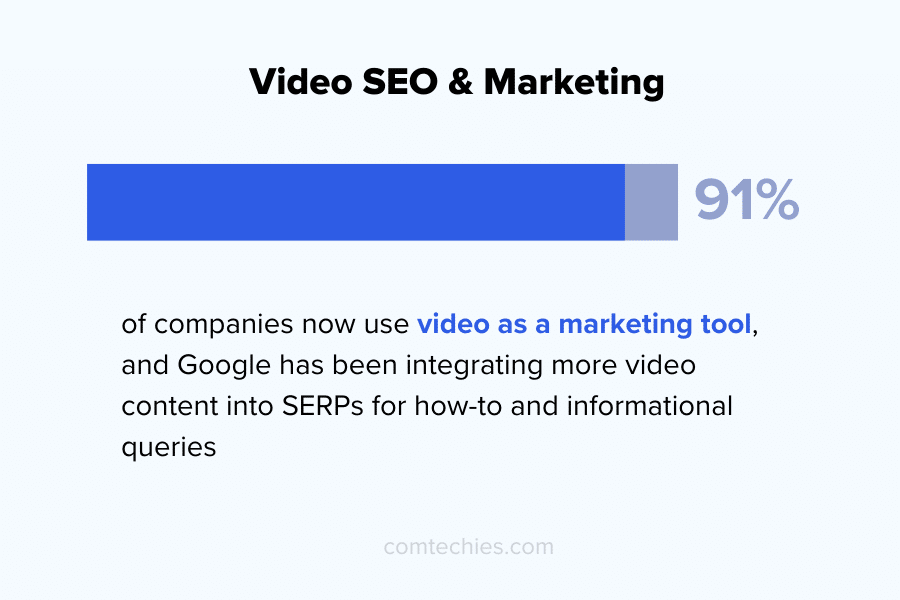
Earning a spot in a SERP feature can greatly increase your visibility. By structuring your content clearly, aim to be the source of featured snippets and PAA answers.
At the same time, accept that some searches won’t yield clicks. Part of 2025 SEO is adjusting to a world where sometimes your best outcome is brand exposure rather than a click.
For example, someone may see your brand in a featured snippet or Knowledge Panel, and that influences them, even if they don’t click through immediately.
Click-Through Rates & User Behavior on SERPs
It’s important to understand how users interact with search results in 2025. Here are some key insights on click-through rates (CTR) and behavior.
- The #1 organic result captures about 28-30% of clicks on average, #2 around 15%, #3 around 11%, and so on, totaling roughly 50+ % for the top 3.
- One study found 54% of all clicks go to the first three organic results.
- Moving up just one spot on page 1 can improve your expected CTR by about 32% (relative).
- 75% of users never scroll past the first page of results.
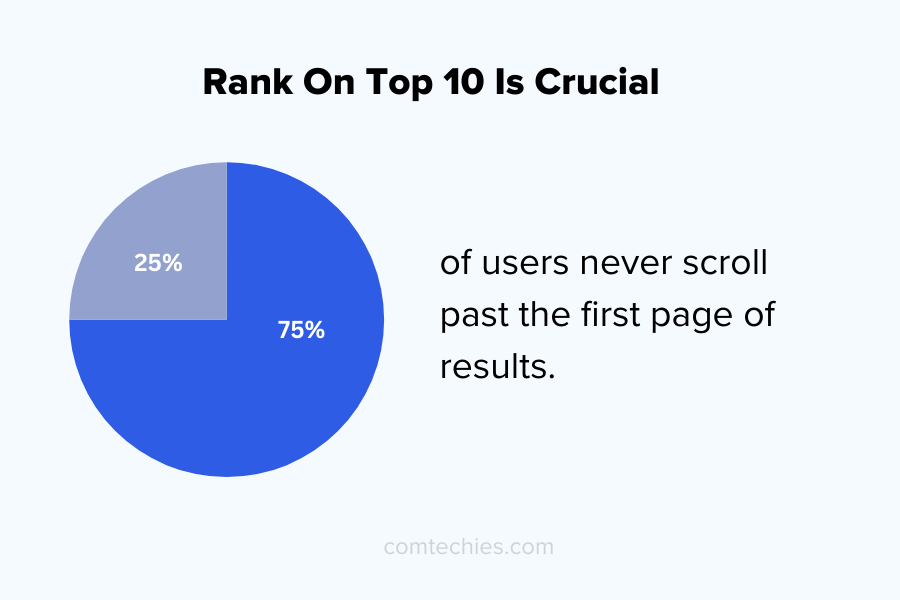
- According to Backlinko, 0.44% of Google users click on something on the second page. Page 2 might as well not exist for most people. So, being result #12 vs result #50 doesn’t make a huge difference. Both are practically invisible. This is why SEO efforts are so focused on top 10 rankings.
- The rise of zero-click means tracking CTR is tricky. As noted, 60% of searches end without a click.
- Rand Fishkin’s study found that of 1000 searches in the US, on average, 415 result in a click (360 to organic, 28 to Google properties, 27 to ads).
Focus on ranking as high as possible for your target keywords. Optimize your title tags and meta descriptions to entice clicks (even if Google sometimes rewrites them, a compelling snippet can improve your CTR).
Use tools like Google Search Console to monitor your pages' CTR for various queries. If you see a page ranking well but with a low CTR, you might need to tweak the title/description or add schema to stand out.
Finally, acknowledge the reality of zero-click searches. Sometimes users will get what they need without visiting you.
In those cases, think about what info you can provide on the SERP (through snippets, schema, etc.) to capture still interest, or what alternative keywords might be more “clicky.”
Understanding user behavior patterns can help you adjust your strategy to capture as much of the available traffic as possible.
AI and Search: How Generative AI is Shaking Things Up or Not?
2024 was the year generative AI truly became popular. Tools like ChatGPT exploded in popularity, and search engines responded by incorporating AI into the search experience (Google’s Search Generative Experience, Bing’s AI chat integration, etc.).
So, where do we stand in 2025 with AI and search?
Let’s separate hype from reality with some stats.
- 99% of people who use generative AI platforms also continue to use traditional search engines.
- In 2024, Google Search received 373 times as many searches as ChatGPT did. And Google had 290 times more users than Perplexity.ai.
- By January 2025, AI overviews appeared in about 30% of Google search results (for program users) and in as many as 74% of problem-solving queries.
- A survey of SEO professionals found that 63% reported Google’s AI overviews (AIO) had positively impacted or at least not harmed their organic traffic/visibility since rollout.
- One analysis said about 16.4% of search users also use GenAI for search tasks.
- According to one survey, 83% of SEO professionals believe that AI will have a positive impact on SEO in 2024 by improving efficiency and insights
- 65% of SEO pros report better results when incorporating AI tools into their strategies.
- According to the report, a 90% cost reduction in generating AI overviews by late 2024, indicating they plan to scale it up (possibly to more users and queries).
Keep an eye on AI developments, but don’t panic. SEO isn’t dead.
Continue to optimize your content for humans first, but also structure it such that AI (whether it’s Google’s algorithms, LLM SEO or AI chatbots) can easily understand it.
For instance, well-structured, true content with clear headings will do well in both traditional search and AI summaries.
Consider experimenting with AI tools to improve your own workflow (content ideas, schema generation, etc.).
Link Building in 2025: Is It Still Worth It?
Backlinks have been used in SEO for many years. But with all the changes and spam updates, you might wonder, is link building still effective in 2025? The answer is yes.
Here’s the state of link building:
- #1 result having 3.8x more backlinks than #2-#10 shows how top-ranking pages often have an edge in link equity. So earning quality backlinks can absolutely improve your SEO.
Quality over quantity (in link building too).
Google’s Penguin algorithm(and its integration into the core) ensured spammy link tactics are far less effective.
Thousands of low-quality directory links or comment spam links can’t fool Google like it might have 10-15 years ago. In 2025, it’s all about relevant, authoritative links.
A single link from a reputable site in your industry (say a .edu site or a well-known publication) can outweigh dozens of average links.
- A 2023 survey by Authority Hacker found 74.3% of link builders admit to paying for links, and the average cost of a paid link was around $83.
It takes about 3 months on average for a new backlink’s impact on rankings to be noticeable. Google must crawl the link, evaluate it, and perhaps wait for the right time.
So link building is long-term, which is why consistently earning links over time is key rather than expecting instant jumps from a link spike.
Link building is absolutely still worth it, but you need to do it correctly.
Aim to earn links by creating link-worthy content or tools and building relationships (with journalists, bloggers, industry sites).
Don’t depend only on “natural” attraction, often you have to be proactive. Do outreach, send a friendly email highlighting your new research, etc.
Over time, as your site’s backlink profile grows with quality links, your domain’s authority and rankings will likely improve.
Just be patient and consistent. Ensure your site is worthy of links. Nobody wants to link to an average site, so link building and content improvement go hand in hand.
In 2025, think of link building as building credibility and getting attention online. The links (and SEO benefits) will follow if you focus on that.
Expert Predictions for 2025: What’s Next in SEO
I have compiled predictions supported by experts about SEO in 2025 (and beyond) so you can see where it might be headed.
Here’s what top SEO experts and recent industry surveys are saying.
Back to Basics, you need to focus on Fundamentals and UX. Experts often advise that doubling down on the basics will serve you well in an age of constant change.
SEO consultant Jono Alderson urges teams to “Make 2025 the year you actually optimize your website and fix your errors. Make it faster and Improve the UX. Trim the fat.”
Similarly, others say to focus more on UX.
Arnout Hellemans advises looking beyond keywords to “usability, site speed” and ensuring your content actually satisfies the intent behind 'People Also Ask'(PAA) questions users have.
Google’s algorithm is increasingly aligned with user experience, so a better site ultimately equals better SEO outcomes.
SEO is becoming “Search Everywhere Optimization.”
As one local SEO expert put it, the meaning of SEO is shifting from Search Engine Optimization to “Search Everywhere Optimization”.
What does that mean?
It means optimizing your brand’s presence across multiple platforms and mediums, not just your website for Google.
With users finding info on Reddit, YouTube, TikTok, and AI answers, brands need to be visible where people are looking.
For example, you might optimize your YouTube videos (video SEO), answer questions on Quora/StackExchange, be active on forums or Reddit in your niche, etc.
"AI will continue to integrate, not destroy".
Most people agree that AI will become a bigger part of search (with more advanced AI answers, maybe multimodal results combining text, video, and images), but it’s not going to kill SEO.
Experts like Mark Williams-Cook note Google is making AI answers much cheaper to produce, suggesting “even more aggressive deployment” of AI in results.
For SEOs, the prediction is to focus on content that AI can’t easily replace original research, unique expertise, opinion, and creativity. SEOs will also need to optimize for AI discovery.
For example, ensuring your content is structured so AI can pull from it (good schema, clear writing).
Some predict shifts in content strategy due to changes in user behavior. For example, one tip is to start with video-first content for some topics.
With Google showing more videos and younger audiences searching YouTube/TikTok, creating video content (and then repurposing it into text) can capture traffic you might otherwise miss.
Additionally, others say Q&A-style content will be more relevant than ever, partly because of voice search and PAA. So, having FAQ sections and conversational content can align with what users (or AI assistants) are looking for.
50% of SEO pros expect search traffic from social media search engines (like searching within TikTok, Instagram) to grow. That suggests optimizing content for discovery on those platforms too (e.g., using trending sounds on TikTok or hashtags effectively).
On a higher level, the role of an SEO is broadening. Knowledge of AI tools, content creation, data analysis, UX, and even public relations is becoming part of the SEO toolkit.
The experts advise staying adaptable and continuously learning. Many suggest that while tools (from Semrush to ChatGPT) can automate a lot, the strategic and creative input of human SEOs is more valuable than ever.
The future of SEO in 2025 looks bright, but different.
Conclusion
I have covered a lot from traffic patterns and ranking factors to mobile, local, voice, AI, content, links, and future predictions.
SEO in 2025 has many parts. Google is still the dominant player, but how people search and what they expect from results has evolved.
To succeed, you must excel in fundamentals (great content, solid tech SEO, quality links) and adapt to new realities (zero-click searches, AI in search, etc.). It’s a challenging yet exciting time to be in SEO.
Remember, each statistic and trend is a clue to user behavior. Use these insights to inform your strategy. Maybe you’ll invest more in content quality, speed up your site, experiment with voice optimizations, or earn that authoritative backlink you’ve been after.
If you found these statistics helpful, consider bookmarking this page as a reference and feel free to share it with fellow marketers who want to know where SEO stands today.

